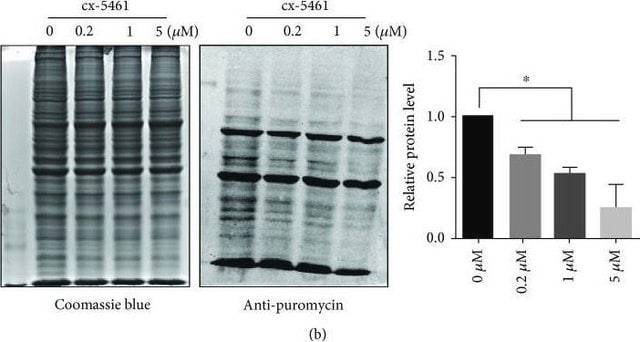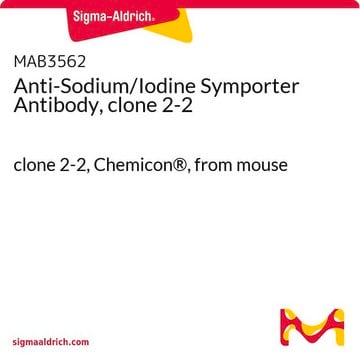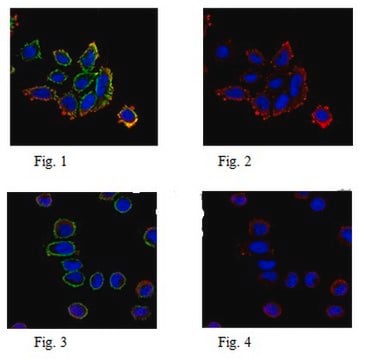Detection of O-propargyl-puromycin has not been validated. An independent researcher has shown that 12D10 may bind to O-propargyl-puromycin treated samples with reduced sensitivity (Yeast. 2014 Mar 19;31(5):167–178).
MABE343
Anti-Puromycin-Antikörper, Klon 12D10
clone 12D10, from mouse
Synonym(e):
Anti-Puromycin Klon 12D10, Anti-Puromycin-Antikörper, Puromycin Nachweisantikörper
Größe auswählen
€ 509,00
Größe auswählen
About This Item
€ 509,00
Empfohlene Produkte
Biologische Quelle
mouse
Qualitätsniveau
Antikörperform
purified immunoglobulin
Antikörper-Produkttyp
primary antibodies
Klon
12D10, monoclonal
Speziesreaktivität
human
Speziesreaktivität (Voraussage durch Homologie)
all
Methode(n)
flow cytometry: suitable
immunocytochemistry: suitable
immunofluorescence: suitable
immunohistochemistry: suitable
immunoprecipitation (IP): suitable
western blot: suitable
Isotyp
IgG2aκ
Versandbedingung
wet ice
Posttranslationale Modifikation Target
unmodified
Angaben zum Gen
human ... NPEPPS(9520)
Verwandte Kategorien
Allgemeine Beschreibung
Spezifität
Immunogen
Anwendung
Immunzytochemie-Analyse: Eine 1:10.000-Verdünnung einer repräsentativen Probe detektierte neu synthetisierte Proteine mit integriertem Puromycin in HeLa-Zellen, die mit Puromycin behandelt wurden.
Analyse durch Western Blotting (WB): Eine repräsentative Probe detektierte neu synthetisierte Proteine mit integriertem Puromycin bei WB (Reineke, L. C., et al. (2012). Mol Biol Cell. 23(18):3499-3510.; Trinh, M. A. et al. (2012). Cell Rep. 1(6):678-688.; Fortin, D. A., et al. (2012). J Neurosci. 32(24):8127-8137.; Clavarino, G., et al. (2012). PLoS Pathog. 8(5):e1002708.; David, A., et al. (2012). J Cell Biol. 197(1):45-57.; White, L. K., et al. (2011). J Virol. 85(1):606-620.; Hoeffer, C. A., et al. (2011). Proc Natl Acad Sci USA. 108(8):3383-3388.; Goodman, C. A., et al. (2010). FASEB J. 25(3):1028-1039.; Schmidt, E., K., et al. (2009). Nat Methods. 6(4):275-277.; Santini, E., et al. (2013). Nature. 493(7432):411-415.; Quy. P. N., et al. (2013). J Biol Chem. 288(2):1125-1134.; Hulmi. J. J., et al. (2012). Am J Physiol Endocrinol Metab. 304(1):E41-50.; Bhattacharya, A., et al. (2012). Neuron. 76(2):325-337.; Hoeffer, C. A., et al. (2013). J Neurophysiol. 109(1):68-76.).
Immunfluoreszenz-Analyse: Eine repräsentative Probe detektierte neu synthetisierte Proteine mit integriertem Puromycin bei WB (Reineke, L. C., et al. (2012). Mol Biol Cell. 23(18):3499-3510.; Trinh, M. A. et al. (2012). Cell Rep. 1(6):678-688.; Fortin, D. A., et al. (2012). J Neurosci. 32(24):8127-8137.;David, A., et al. (2012). J Cell Biol. 197(1):45-57.; David, A., et al. (2011). J Biol Chem. 286(23):20688-20700.; White, L. K., et al. (2011). J Virol. 85(1):606-620.; Hoeffer, C. A., et al. (2011). Proc Natl Acad Sci USA. 108(8):3383-3388.; Schmidt, E., K., et al. (2009). Nat Methods. 6(4):275-277.; Goodman, C. A., et al. (2012). Proc Natl Acad Sci USA. 109(17):E989.; Santini, E., et al. (2013). Nature. 493(7432):411-415.; Quy. P. N., et al. (2013). J Biol Chem. 288(2):1125-1134.).
Immunhistochemie-Analyse (ICH): Eine repräsentative Probe detektierte neu synthetisierte Proteine mit integriertem Puromycin bei IHC (Goodman, C. A., et al. (2010). FASEB J. 25(3):1028-1039.).
Fluoreszenzaktivierte Zellsortierungsanalyse (FACS): Eine repräsentative Probe detektierte neu synthetisierte Proteine mit integriertem Puromycin bei FACS (David, A., et al. (2012). J Cell Biol. 197(1):45-57.; Schmidt, E., K., et al. (2009). Nat Methods. 6(4):275-277.).
Alexa Fluor™ ist eine eingetragene Handelsmarke von Life Technologies.
Epigenetik & Zellkernfunktion
RNA-Stoffwechsel & Bindungsproteine
Qualität
Analyse von Western Blotting: Eine 1:25.000-Verdünnung dieses Antikörpers detektierte neu synthetisierte Proteine mit integriertem Puromycin in HEK293-Zelllysaten, die nur mit Puromycin behandelt wurden. Dieser Antikörper detektierte zudem geringe Mengen neu synthetisierter Proteine mit integriertem Puromycin in HEK293-Zelllysaten, die mit Puromycin und Cycloheximid behandelt wurden.
Zielbeschreibung
Physikalische Form
Lagerung und Haltbarkeit
Hinweis zur Analyse
HEK293-Zelllysate, die mit Puromycin und Cyclohexamid, oder nur mit Puromycin, behandelt wurden.
Sonstige Hinweise
Rechtliche Hinweise
Haftungsausschluss
Sie haben nicht das passende Produkt gefunden?
Probieren Sie unser Produkt-Auswahlhilfe. aus.
Empfehlung
Lagerklassenschlüssel
12 - Non Combustible Liquids
WGK
WGK 1
Flammpunkt (°F)
Not applicable
Flammpunkt (°C)
Not applicable
Analysenzertifikate (COA)
Suchen Sie nach Analysenzertifikate (COA), indem Sie die Lot-/Chargennummer des Produkts eingeben. Lot- und Chargennummern sind auf dem Produktetikett hinter den Wörtern ‘Lot’ oder ‘Batch’ (Lot oder Charge) zu finden.
Besitzen Sie dieses Produkt bereits?
In der Dokumentenbibliothek finden Sie die Dokumentation zu den Produkten, die Sie kürzlich erworben haben.
Kunden haben sich ebenfalls angesehen
Artikel
Explore the basics of working with antibodies including technical information on structure, classes, and normal immunoglobulin ranges.
Antibodies combine with specific antigens to generate an exclusive antibody-antigen complex. Learn about the nature of this bond and its use as a molecular tag for research.
Die Immunfluoreszenz (IF), bei der ein Antikörper an ein Molekül konjugiert ist, das bei Laseranregung fluoresziert, wird u. a. für die Lokalisation von Proteinen, die Bestätigung posttranslationaler Modifikationen oder Aktivierungen und die Ermittlung der Nähe zu bzw. die Komplexbildung mit anderen Proteinen verwendet.
Flow cytometry dye selection tips match fluorophores to flow cytometer configurations, enhancing panel performance.
Protokolle
Learn key steps in flow cytometry protocols to make your next flow cytometry experiment run with ease.
Explore our flow cytometry guide to uncover flow cytometry basics, traditional flow cytometer components, key flow cytometry protocol steps, and proper controls.
Tips and troubleshooting for FFPE and frozen tissue immunohistochemistry (IHC) protocols using both brightfield analysis of chromogenic detection and fluorescent microscopy.
-
Does the antibody recognize O-propargyl-puromycin (OP-puro)?
1 answer-
Helpful?
-
-
What's the concentration (mg/mL) of anti-Puromycin antibody (MABE343) ?
1 answer-
The concentration of this product is 1 mg/mL. This information is published in the lot-specific Certificate of Analysis. Please see the link below to review a sample or lot-specific Certificate:
https://www.emdmillipore.com/product/Anti-Puromycin-Antibody-clone-12D10,MM_NF-MABE343#anchor_COAHelpful?
-
-
Does the Anti-Puromycin Antibody (MABE343) exhibit specificity for puromycin incorporated into proteins, or does it bind to any puromycin?
1 answer-
The Anti-Puromycin Antibody (MABE343) likely detects puromycin only when it is incorporated into proteins, as indicated on the webpage. Researchers may need to review the numerous citations for this antibody to confirm this specificity.
Helpful?
-
Active Filters
Unser Team von Wissenschaftlern verfügt über Erfahrung in allen Forschungsbereichen einschließlich Life Science, Materialwissenschaften, chemischer Synthese, Chromatographie, Analytik und vielen mehr..
Setzen Sie sich mit dem technischen Dienst in Verbindung.







